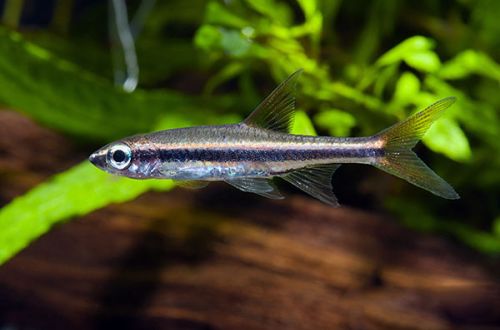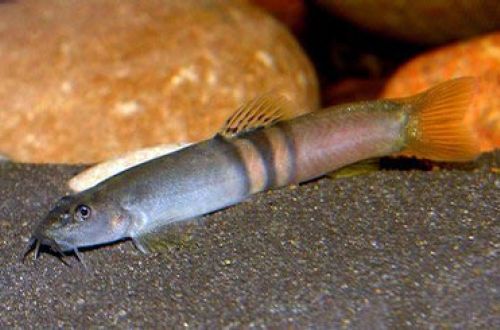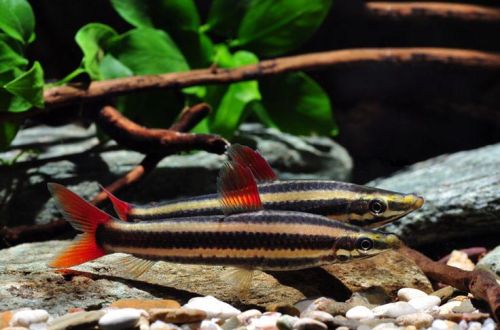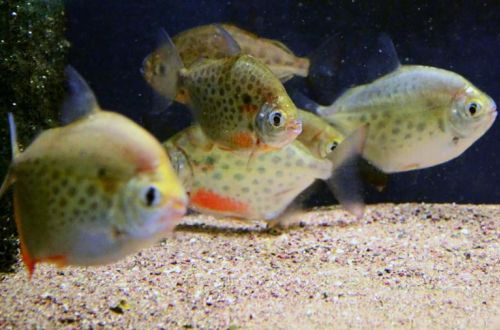
Rasbora slim
Rasbora slender, scientific name Trigonopoma gracile, belongs to the Cyprinidae family. A miniature moving fish, a flock of which can decorate any freshwater aquarium. Easy to maintain and compatible with many other species. May be recommended for beginner aquarists.

Contents
Habitat
Originally from Southeast Asia from the Malay Peninsula and the Greater Sunda Islands (Borneo and Sumatra). They inhabit swamps and rivers connected with them, the water in which is colored dark brown due to the abundance of tannins. These reservoirs are usually located under the canopy of the rainforest and are littered with a lot of plant debris (leaves, branches, tree trunks).
Brief information:
- The volume of the aquarium – from 70 liters.
- Temperature – 21-26°C
- Value pH — 4.0–7.0
- Water hardness – soft (1-8 dGH)
- Substrate type – any
- Lighting – subdued
- Brackish water – no
- Water movement is weak
- The size of the fish is 4–5 cm.
- Food – any food
- Temperament – peaceful
- Keeping in a group of 8-10 individuals
Description
Adults reach a length of about 5 cm. The fish has a slender body and large pointed fins. The eyes stand out in particular, they seem very large in body proportions and are designed to search for food in conditions of poor lighting and clear water. In the body pattern there is a wide horizontal stripe of black color, stretching from the head to the tail. This strip divides the body of the fish into a gray back and a silvery belly. Sexual dimorphism is weakly expressed and lies in size – females are somewhat larger and “rounder” than males.
Food
Omnivorous species, will accept most popular aquarium foods. The daily diet may look like this – dry flakes or granules in combination with live or frozen brine shrimp, bloodworms, daphnia. It is permissible to serve only dry food, but of high quality and from well-known manufacturers.
Maintenance and care, arrangement of the aquarium
The optimal size of the aquarium for a small flock of fish starts from 60 liters. In the design, it is desirable to set a subdued level of light, use dark soil, a large number of aquatic shade-loving plants and various kinds of snags. Although the fish can adapt to other conditions and even live in an empty tank. In the latter, they are often sold in pet stores.
Water conditions should be close to natural not only in terms of hydrochemical composition, but also in terms of the presence of tannins, which give the water a characteristic brown color. To do this, the leaves of trees are immersed in the aquarium, for example, oak or more exotic leaves and bark of Indian almonds. Read more in the article “Which tree leaves can be used in an aquarium.”
Maintenance of the aquarium is standard: weekly replacement of part of the water with fresh water and control of its parameters, regular cleaning of organic waste.
Behavior and Compatibility
A peaceful schooling fish, a great addition to other non-aggressive species of comparable size. The slender Rasbora looks especially harmonious in the neighborhood with fish from Southeast Asia. It is recommended to keep in a flock of 8-10 individuals – the more the better.
Breeding / breeding
In favorable conditions, spawning will occur regularly. Like most small cyprinids, this species scatters eggs in the water column and does not take care of its offspring, therefore, in a general aquarium, the survival of fry will be minimal, despite the large number of eggs. Juveniles fall prey to adult fish and die from malnutrition, since it is extremely difficult to provide them with constant food in a large volume of water.
If you plan to keep the entire brood, then you will need to install a separate tank with identical water conditions, where the eggs will be transferred. This spawning aquarium is equipped with a simple airlift filter with a sponge and a heater. A separate lighting system is not required, the light that will come from the room is enough. As decoration, you can use artificial plants or mosses with ferns that can grow in low light.
The incubation period lasts about 24 hours, after another 3-4 days the fry begin to swim freely in search of food. Feed specialized microfoods and/or brine shrimp nauplii.
Fish diseases
Hardy and unpretentious fish. If kept in suitable conditions, then health problems do not arise. Diseases occur in case of injury, contact with already sick fish or significant deterioration of the habitat (dirty aquarium, poor food, etc.). Read more about symptoms and treatments in the Aquarium Fish Diseases section.





